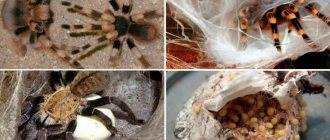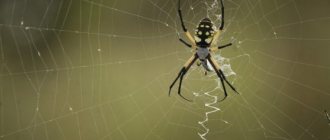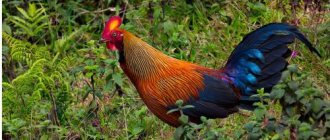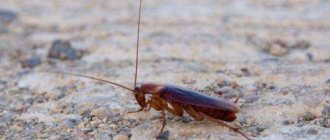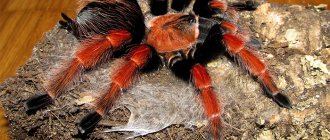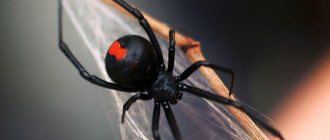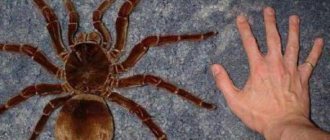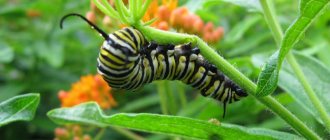Poisonous spiders in bananas in Russia 2022 true or myth? The name and photo of this insect, interesting facts. What happens if a Brazilian spider bites you?
The spiders that people around the world find in bananas are actually called Brazilian wandering spiders, but people also call them “banana spiders” because they love to hide in this fruit.
According to the Guinness Book of Records, these are the most poisonous spiders. Mortality from their poison occurs more often than from the “black widow”. Of course, such an insect is unlikely to kill an adult healthy person, but it may well kill a child. In our latitudes it is almost impossible to meet this spider, but such a case has already happened.
Spider eggs under a banana peel
In 2013, a woman in Samara bought a bunch of bananas at the market, and when she came home, she found a Brazilian spider in the bag. Without panicking, she locked it in a jar and took it for examination, which showed that it was the same insect. From this story we can conclude that this living creature exists and can actually be found in Russia, which is not surprising, because some of the bananas are brought to us from Brazil.
This wingless creature is approximately 12 cm in diameter, has a motley color, and has a small coat of fur. It lives mainly in South America, but travels on bananas all over the world. They do not eat the fruit itself, but only hide in it. They prefer other small insects or lizards as food. Poisonous spiders bite people for self-defense. They multiply very quickly. They don't weave a web. They live mainly in trees, bushes and in the ground.
Record-breaking lethality
The Brazilian soldier spider acquired its reputation as the most dangerous spider on the planet, not least thanks to its aggressive behavior.
As soon as a situation arises that it identifies as dangerous, the spider takes a special stance on its legs, stretching threateningly upward and pointing its front legs towards the enemy. The indicative aggressiveness of the Brazilian soldier spider is associated with its focus on active hunting. While pursuing a victim, it can develop a running speed decent for a spider, and is also capable of jumping a considerable distance.
Since the spider loves to enter people's homes in search of a calm, quiet place, its meeting with
in humans - this is a fairly common occurrence. Unfortunately, they often have a tragic outcome. The impact of the venom of the Brazilian wandering spider on children and the elderly is especially dangerous.
The content of a powerful neurotoxin in the poison causes the victim to experience total muscle paralysis, leading to fatal suffocation. A person bitten by this spider feels terrible pain throughout the body and complete numbness. As a rule, the subsequent muscle paralysis causes death. From the time of the bite to death can take from 2 to 6 hours.
If you are bitten by a Brazilian soldier spider, you should immediately seek help from a medical facility. Currently, there is an antidote for the bite of this spider, although it is extremely toxic to the body.
Reproduction
Brazilian wandering venomous spiders are heterosexual. The female has a bright color, her size significantly exceeds that of the male. Males, in turn, are distinguished by the presence of additional limbs; they need them during the mating period.
The traveler spider is a good dancer, which attracts the female . Flirting is combined with the presentation of food. When the frozen female eats food, the spider mates. At the end of sexual intercourse, the partner usually eats the inseminator. In rare cases, the male remains in the family and lives in the same nest.
2 weeks after mating, the female lays eggs. Her mission ends when new offspring emerge from the cocoon. The young hatch from the eggs 3 weeks after laying. Then they crawl away in search of food and then serve themselves independently. Up to 100 small spiders can be born at one time.
What does it look like
The Brazilian banana spider, also known as the wandering, wandering spider, soldier, grows to a size of 4 cm, with legs spread out - 12 cm. Males are half that size.
- The body consists of a convex abdomen, cephalothorax. Covered with small dense hairs.
- The color is gray, almost black.
- A black stripe runs along the body.
A photo of a banana spider is located below.
The legs are long and powerful. They serve not only for movement, but are also organs of smell and touch. There are 8 eyes on the head, providing a 360-degree visual field. The Brazilian wandering spider sees silhouettes, shadows, and reacts well to movement.
The distinctive feature is not its appearance or size, but the special pose that the banana spider takes before attacking. He stands on his hind legs, raises his upper limbs, and spreads them to the side. From this position, the predator practically jumps at lightning speed onto the prey, the enemy, and injects a toxic substance.
Nutrition

